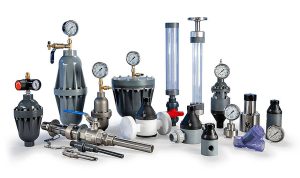From the simplest garden hose to the intricate network of industrial pipelines supporting manufacturing across the United States, the fundamental movement of fluids underpins countless essential processes. Here at Griffco Valve, we dedicate our expertise to providing the crucial accessories that ensure these diverse fluid systems operate with optimal efficiency, unwavering safety, and long-term reliability. To truly grasp the vital role played by our back pressure valves, pressure relief valves, pulsation dampeners, and other critical components, it’s essential to delve into the foundational principles that govern all fluid movement: the science we know as fluid dynamics.
Fluid dynamics, a core branch of physics, meticulously studies the motion of both liquids and gases. This field encompasses an incredibly wide spectrum of phenomena, ranging from the smooth, predictable laminar flow of a viscous fluid to the often-unpredictable and chaotic nature of turbulent flow. A solid understanding of these fundamental principles equips engineers and technicians nationwide with the knowledge necessary to effectively design, precisely optimize, and efficiently troubleshoot fluid handling systems across a multitude of industries. Whether your work involves delicate chemical feed systems, large-scale water treatment plants, or complex manufacturing processes, a comprehensive grasp of basic fluid dynamics is an invaluable tool for predicting fluid behavior and selecting the most appropriate system components.
The Basics of Fluid Motion
Several key concepts form the bedrock of our understanding of fluid dynamics. Viscosity describes a fluid’s inherent resistance to flow. Density refers to the amount of mass within a specific volume. Pressure, the force exerted per unit area, is fundamental; Pascal’s principle explains its transmission in closed systems, crucial for understanding pressure relief valves. Flow rate, the volume passing a point per unit time, is vital for efficient operation. These properties significantly influence how fluids behave within a system, impacting everything from pump selection to pipe sizing in applications throughout the United States.
Laminar vs. Turbulent Flow
Fluid flow occurs in two main regimes: laminar, characterized by smooth, parallel layers, and turbulent, which is chaotic with swirling eddies. The Reynolds number, a dimensionless quantity, helps predict which regime will occur based on fluid properties and flow conditions. Understanding the flow regime is crucial for selecting appropriate system components to minimize energy losses and ensure efficient operation in various industrial settings across the United States.
The Role of Pressure in Fluid Systems
Pressure differences drive fluid flow; pumps are employed to create these pressure differentials to overcome frictional losses and elevation changes within a system. Pressure relief valves are essential safety mechanisms that automatically release excess pressure, safeguarding equipment and personnel in facilities across the country. Similarly, back-pressure valves maintain a necessary minimum upstream pressure, ensuring consistent flow rates crucial for many industrial processes. Both types of valves rely on the core principles of fluid dynamics for effective operation and the maintenance of system integrity.
Griffco Valve: Optimizing Fluid System Performance
At Griffco Valve, we deeply understand the intricacies of fluid dynamics and their impact on your operations. Our comprehensive range of accessories is engineered with these principles at its core. Our back pressure valves help maintain stable flow, while our pressure relief valves provide vital overpressure protection for systems used throughout the United States. Pulsation dampeners mitigate damaging pressure spikes, and our calibration columns enable precise chemical metering essential in various industries nationwide. Injection valves and y-strainers play a crucial role in protecting system integrity, all thanks to the principles of fluid dynamics. Our experienced team provides knowledgeable support to help you select the ideal accessories for your specific applications, ensuring optimal system performance.
Applications Across Industries
The principles of fluid dynamics are fundamental across a wide range of industries vital to the US economy. Water treatment plants rely on these principles for efficient purification processes. Chemical processing demands precise flow control for accurate reactions. The oil and gas sector manages complex hydrocarbon flows along the Gulf Coast and beyond. Even agriculture utilizes these concepts for efficient irrigation. Griffco Valve proudly serves these diverse sectors, providing reliable accessories engineered for their specific needs, always grounded in the core tenets of fluid dynamics. Our commitment extends to ensuring that our products meet the diverse and evolving needs of industries across the nation.
Looking Ahead in Fluid Dynamics
The field of fluid dynamics continues to evolve, with advancements like computational fluid dynamics (CFD) offering increasingly sophisticated analytical capabilities. At Griffco Valve, we remain committed to integrating these advancements into our product development, ensuring our customers benefit from the most reliable and innovative solutions available. Our dedication to quality and a deep understanding of fluid motion make us a trusted partner for fluid handling accessory needs throughout the entire United States. We continuously strive to enhance our product offerings and provide cutting-edge solutions based on the latest developments in fluid dynamics.

